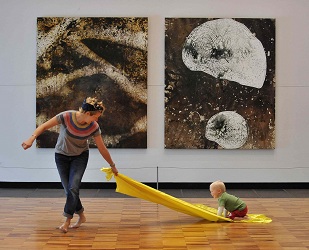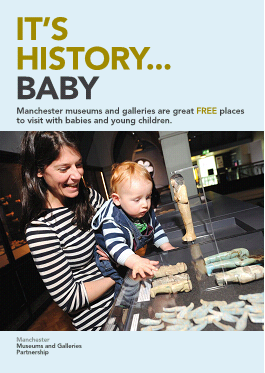A trip to a museum is…. holding a friend’s hand, waiting at a bus stop, climbing the stairs, looking out of the window at the world around us, talking to someone new, going through a secret door, finding a snake, marvelling at an owl, seeing a dinosaur, drawing a fox, writing a label, counting the claws, holding a torch, taking a photo, spending time with dad…(Foundation stage teacher describing a visit to Manchester Museum)

In Manchester, at the Whitworth, Manchester Museum and Manchester Art Gallery, we are working together to become brilliant spaces for young children and their grown ups – aspiring to be exploratory and participatory spaces where young children take the lead; imaginative spaces which draw on our collections, visual and material culture and artists (as well as children’s own capacity for curiosity and imagination); and social spaces which encourage cooperation, creativity and connectivity.
Over the last 4 years, we’ve worked hard to develop the breadth and quality of our engagement by working with families, early years settings and educators, children’s hospitals and health visitors and a range of targeted third sector agencies. As a result, our youngest visitors are amongst our fastest-growing and most diverse audience. Since 2009, participation by young children and families at the Whitworth has increased by 400% and in the last 18 months, with a more strategic approach and dedicated member of staff, visits from under 5s have increased by 73%. We have secured additional investment and are building a highly informed, specialist Early Years workforce, responsive to the contribution of art and culture to childhood development and we are learning to engage with the different needs of 0-2 and 3-5 year olds. By promoting enquiry-based and often child-led activity, this means developing our role as facilitators rather than teachers or leaders and learning how to be more confident and comfortable with the uncertainty and ambiguity this approach necessarily entails. We care about and have built a reputation for this work, receiving the Clore Award for Museum Learning in 2012 for our work with under 5s, with particular recognition of our innovative work with babies.

Babies – seriously?
We know, from research and feedback from parents and teachers that working with young children in our museums and galleries has strong outcomes in personal, social, language and emotional development. However, it is only recently that we have started to realise the potential of our sites as rich early communication environments for under-twos and babies. This is a critical time and we take babies very seriously indeed, believing there is a strategic as well as local and individual need for this work; from understanding the importance of early interventions in a city-region that has below national averages in attainment to acknowledging that being a new parent can sometimes be a scary and socially isolating time and considering how our museums and galleries might provide a supportive social context for family learning. We started working with under-twos, particularly babies-before-they-walk, in 2011. Since then, we have developed participatory programmes and partnerships with nurseries, parent groups, health visitors, post-natal and family services and we are learning more all the time. Our blog brings all this together and includes films, research and evaluation, ideas and tips for welcoming babies to your venue. Here are just a few of our top tips for working with babies
Is you venue baby ready?
It’s the little things that say ‘you’re welcome here’. Think about providing emergency supplies of nappies, wet wipes and nappy bags for parents who get caught short on a visit or changing mats in sessions so that parents don’t have to wander too far.
Babies put things in their mouths.
This is how they experience the world around them. Germs are a normal part of growing up and baby wipes are more than adequate for cleaning objects. You can also enable babies to experience small objects safely by putting them in small bags, in tights or in a controlled area
Infant science is telling us more and more about what babies can see.
Babies respond best to high contrast colours like black, white and red and less well to blues and yellows. Think about colour combinations and removing unwanted visual stimulus as they respond to order and beauty too
Families come in all shapes and sizes.
Don’t forget about dads and grandparents and parents/carers with twins or triplets.
There’s no right or wrong way.
Let babies take the lead, watch how they interact with objects and learn from them. Photographs, films and written observations can be a useful tool to keep track of your progress. And don’t be afraid to try new things.

These tips are taken from a series of principles which guide our work. Earlier this year, we teamed up with Kids in Museums to deliver the first sell-out Babies in Museums workshop focused on finding out how babies learn, seeing babies in action, sharing tips and encouraging more museums to welcome and engage this audience. The next Babies in Museums workshop will be on Thursday 26 September at the Museum of Childhood, London. At present, babies in museums are still viewed as a novelty but we hope to change that and believe firmly that you’re never too young to start learning in museums.
Back to top




